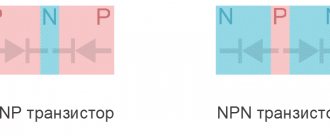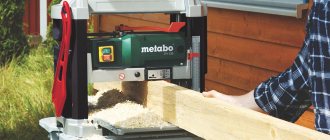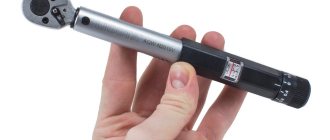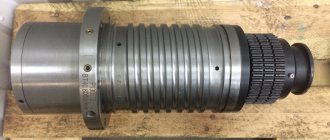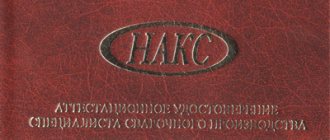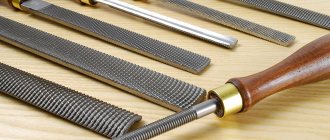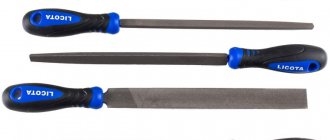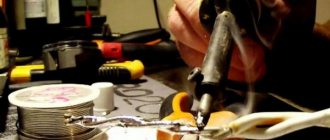What is flux used for?
The main functions of these substances are the following:
- Removing films of foreign substances that interfere with the soldering process;
- Improved wetting of soldered parts;
- Improving the spreading of solder and its fixation with the surfaces being soldered;
- Preventing oxidation of metal heated during the soldering process.
Without the use of flux, the soldering process may be ineffective, and the reliability and quality of the work performed may be very low.
Types of rosin solder
Currently, such solder with rosin is manufactured in several versions. It is customary to distinguish such filler material depending on the rosin content, wire thickness and a number of other features. There is a choice of materials for both home use and soldering on an industrial scale. This solder is produced in the form:
- In reels. This is a universal option for surfacing material that can be used by both professional welders in workshops and ordinary homeowners for soldering at home. The thickness of the wire can vary from 0.8 to 2 millimeters. Note that using such coils is extremely convenient. You just need to select the appropriate brand of solder and wire thickness.
- In a tube. This type of solder is made exclusively for home use. Such a tube contains a minimum of material, so if large volumes are needed, you should either buy a large number of tubes at once or choose solder in a coil.
- In the bays. A large amount of material is used, so this design is intended primarily for industrial use. The thickness of the wire can be varied, depending on the specific needs of customers. The coils themselves can be made in different sizes, which somewhat simplifies their use.
Physico-chemical properties of the solder used
The classic composition of such solder with rosin is considered to be tin-lead soft alloys. The tin content is 60% and lead 40%. Accordingly, such a composition gives such solder certain physical properties. The presence of rosin allows for excellent flexibility, as a result of which, before welding, you can select the right amount of such material and correctly position it in the seam. It must be taken into account that such a composition has a low melting point, so it is not possible to use it for joining refractory metals. At the same time, we note that such solder penetrates in a liquid state into all cavities and irregularities, which ensures the strength of the connection. But at the same time, such an additive does not penetrate into the base material.
Low melting temperatures ensure ease of soldering. Lead adds fluidity to the material, but one should take into account the fact that lead may contain toxic fumes, so it is best to perform soldering in a ventilated area. No further precautions are required when soldering.
Types of fluxes
All fluxes are divided into 3 large groups:
- Acidic (active);
- Low-active;
- Neutral (inactive or protective).
Resistor - what is it and what is it for?
The main practical difference between active fluxes and weakly active and neutral ones is the need to remove their residues upon completion of the soldering process - the acids and aggressive salts contained in such substances, remaining on the soldered surfaces or parts, will cause accelerated corrosion.
On a note. In addition to the classification by melting point described above, all these substances are divided into two large groups: fusible and refractory.
Low-melting substances (rosin, its alcohol solutions, soldering acids) are used for soldering ferrous and non-ferrous metals with tin-lead solders at temperatures up to 5000C. Refractory substances (calcined borax, a solution of borax in boric acid, calcium and barium chlorides) are used for soldering ferrous and non-ferrous metals with copper, silver and copper-brass solders at temperatures above 5000C.
Rosin
It is a solid glassy amorphous substance of light yellow or dark orange color, obtained from coniferous resin. Melts at a low temperature, emits little smoke and substances harmful to the human body.
Rosin is used when soldering radio components with low-melting tin-lead solders.
Soldering acids
This type of flux is represented by inorganic low concentrated acids: phosphoric or hydrochloric. To increase the activity of the acid and improve its dissolution of oxide films, a salt such as zinc chloride is often added to it. Due to its fluidity, it is well suited for working in hard-to-reach places.
Soldering acid
Interesting. The disadvantage of soldering acids is the need to remove their residues after completion of soldering work.
Soldering acids are used for tinning corrosion-resistant steels, copper, zinc-coated iron, and parts made of nickel or chromium.
Alcohol solutions
The most common composition of this type is an alcohol-rosin solution, which is a 20-25% solution of rosin dissolved in ethyl alcohol. To increase the activity and range of soldering work performed, various salts are often added to such a solution: zinc chloride, diethylammonium chloride, phenylammonium chloride. Due to its liquid aggregate state, it is well applied to the surfaces to be soldered and does not require removal of residues after completion of soldering work.
Alcohol solutions containing no additives are used for conventional soldering using low-melting solders; varieties containing various active salts are used for soldering ferrous and non-ferrous metals, as well as their alloys (copper, brass, aluminum, etc.).
The main disadvantages of the alcohol-rosin solution are the volatility of the main component - ethyl alcohol, its increased evaporation during soldering and storage in a non-hermetically sealed container.
Aqueous solutions and improvised means
This list of homemade substances is often represented by a 16% aqueous solution of orthophosphoric acid with the addition of 3.7-4.0% ethyl industrial alcohol. Such solutions are used for soldering both ferrous and non-ferrous metals and their alloys.
Ready-made formulations
They are ready-made compositions (flux paste, FPP brand composition), convenient for application and often placed inside tubular solder wire. They are usually used for soldering with low-melting low-temperature solders.
Borax
Borax
Borax is a high-temperature powdered flux used for soldering steel, cast iron, bronze and copper parts using refractory copper-zinc or silver grades of solder.
Borax is often dissolved in boric acid for convenience and to increase efficiency. Due to its low price and wide range of soldering jobs performed with borax, it is universal and in demand both in radio electronics and in soldering non-ferrous and ferrous metals.
Gel fluxes
Gel fluxes are the most convenient and reliable. They are a mixture of crushed rosin powder and solvent. Available in small syringes for special dispensing guns, they are easy to apply and do not require removal from the surfaces to be soldered. Such substances are used for soldering work in radio electronics.
The main advantages of rosin
Main advantages:
- Does not conduct electricity.
- Low cost, available for sale almost everywhere.
- Retains its properties at negative temperatures.
- Not affected by moisture, not washed off with water
- Long shelf life.
- Prevents corrosion on metal structures, effectively removes oxide film from the surface of the material being processed, and degreases the product.
Application of flux
Capacitor - what is it for, device and principle of operation
The method of using these substances is determined by their state of aggregation and chemical composition:
- Solid rosin is applied to the surfaces to be soldered with the tip of a soldering iron, which already has molten solder;
- Soldering acid is applied to the parts or surfaces to be soldered with a small brush, a cotton swab or a simple match;
- Liquid alcohol-rosin flux is applied during tinning using a small dispenser spout mounted on a container with the solution.
- Gel-like substances are applied using special dispensing guns into which cartridges are inserted.
Important! Since fluxes are mostly substances unsafe for human health, maximum care should be taken when applying them. If this tinning substance comes into contact with the skin of your hand, it should be washed off immediately and, if necessary, neutralized with appropriate substances.
Principles of classification
Anyone who does soldering should have an idea of what fluxes exist. There are several well-known and quite accessible substances, for example, borax or rosin, on the basis of which other compositions are made.
In general, the types of fluxes are varied, just as the materials of parts and soldering methods are varied. Approaches to classification are reflected by GOST. The division into groups occurs according to several criteria:
- temperature range of application;
- type of solvent (flux substances are dissolved in alcohol or water);
- type of activator (the main substance that causes protective processes);
- physical state (powder, liquid, paste, gel).
Fluxes exhibit maximum activity in different temperature ranges. One group is recommended for soldering at relatively low temperatures, up to 450 ℃; the second – at temperatures exceeding the specified value.
There is also a division of fluxes according to the mechanism of action, which is closely related to the properties of the activator. Reactions of interaction with the materials of parts can be chemical or electrochemical in nature. In some situations, fluxes provide only protection, in others they have a reactive effect.
Despite the varied characteristics of the compositions, the requirements for them are the same. The product must have a strictly defined fluidity so that the composition covers the working area of the parts, but does not flow beyond it.
Drugs should not enter into uncontrolled reactions. Flux should always have less density and adhesiveness (stickiness) than the mass of solder.
Flux components cannot burn out or evaporate. The final stage is very important. You need to be able to easily clean the soldering area from plaque after finishing work.
How to prepare flux for soldering yourself
Having understood what soldering flux is, it is worth considering the easiest way to independently produce a similar substance used in soldering radio components, for tinning printed circuit boards:
- Several pieces of rosin are wrapped in thick cloth;
- By hitting the resulting bag with a heavy hammer, the rosin inside is thoroughly crushed;
- The resulting crushed rosin is poured into a container with ethyl alcohol and, stirring, dissolved in it completely.
Homemade composition
In order to speed up the dissolution of rosin, place the container with alcohol in a small saucepan with hot water. To obtain a gel-like substance, glycerin is added to the resulting solution.
Russian stamps
Among the domestic products, SKF is noticeable - a soldering flux made from alcohol and rosin. The prepared solution can be used immediately. All components are already mixed. It is easy to use, the residual layer can be easily removed with gasoline or alcohol.
There are many narrowly targeted soldering compounds on the market from Russian manufacturers, designated by abbreviations: LTI, TAGS, ZIL, KRS, LK and so on. They contain highly active ammonium chloride, ammonia, amines, zinc chloride, and other active reagents.
When choosing a flux, pay attention to the recommendations for use. In mixtures, every component matters.
Some types are only suitable for working with hard solders. There are types designed for specific alloys. Thus, special reactive compounds have been developed for soldering aluminum. You should carefully study the label and then select a flux.
How to choose the right flux
In order to choose the right soldering flux, the following criteria must be taken into account:
- Material of soldered surfaces - if parts made of brass, ferrous metals, chromium or nickel are soldered, then borax, boric, hydrochloric or phosphoric acid are used. If you plan to solder radio components that are sensitive to overheating, use low-melting low-temperature fluxes: rosin and its alcohol solutions, gels.
- Ease of application - when soldering printed circuit boards and small radio components, liquid and gel-like substances are used,
- Health safety – gel flux brands are the safest. The leaders in the list of harmful and potentially dangerous substances of this type are acids.
Ready-made formulations
Among the ready-to-use compositions, you can choose a flux for lead, lead-free or rosin-free soldering. Fluxes are produced in the form of pastes that are convenient to apply to metal. Sometimes flux compounds are placed in a hollow solder wire.
Borax
Multifunctional borax is constantly in great demand. This flux has been known for a long time and is suitable for soldering pure copper, copper alloys, cast iron and steel products.
Borax is used in the form of powders or solutions, in pure form or with boric acid and other additives. The flux has an affordable price and a reliable reputation in the market for soldering products.
Gel
Among gel fluxes, Flux-Plus products stand out. Of course, it costs a lot, but the price is compensated by its excellent qualities and ease of use for soldering.
Amtech gels are popular. Original products are more expensive. Flux labeling can be deceiving. Counterfeit products also have such inscriptions.
Oddly enough, this is the only type of flux whose fake will not disappoint. The Chinese product also has good soldering properties. Unlike the original, the residual plaque has to be removed.
How to replace soldering flux
If the necessary flux is not available for some reason, it can be replaced with the following available substances:
- Aqueous solution of aspirin;
- Lemon acid;
- Vinegar;
- Rosin with regular pork fat.
All these available means, although they do not have all the advantages of specialized compounds, if used correctly, soldering using them will be of sufficient quality and reliability.
Thus, having understood what soldering flux is and what it is needed for, we can say that its use is an integral step in soldering technology, without which the resulting connection will be unreliable and short-lived.
Making at home
You can make rosin yourself. The resin of all coniferous trees is suitable, but it is better to take pine. You can take a walk through the coniferous forest, taking with you a container for resin, a scraper, a spoon or a knife.
Only trees that have reached 30 cm in diameter are suitable for resin extraction. It is known that an adult pine tree produces no more than two liters of resin per year. Scientists have proven that resin is not a juice necessary for the normal functioning of a plant, but a means for healing its wounds.
A sufficient amount of resin can be obtained at logging sites, where it appears on cut trees and stumps, or it can be sent to a sawmill. Resin often appears on fresh lumber. The resin should be scraped with a scraper or spoon into a metal pot or jar.
The container filled with resin must be placed on fire. It makes sense to carry out this procedure outdoors since the resin will melt and boil when heated, releasing turpentine vapor. The contents of the pot must be stirred periodically to remove foam and debris. The resin must be heated until it stops boiling and the release of vapors stops.
After the boiling stops, a thick transparent mass of a characteristic yellow color, similar to amber, will remain in the pot. It needs to be poured into molds and allowed to cool. It is better to make forms from cardboard or stiff paper. You can also use plastic containers, but it’s easier to get ready-made rosin from cardboard containers. If inclusions of debris are visible in the resulting rosin, it can be filtered through a fine metal mesh.
So, let's summarize.
The composition of all fluxes is designed for high quality soldering. All of the above fluxes are used in different environmental conditions and with different process features. The main differences between SP fluxes are consistency and activity. Therefore, it is necessary to select flux based on the scope of application and ease of use.
As for CHIPSOLDER brand fluxes, they are not as versatile as SP fluxes. When choosing CHIPSOLDER flux, you must definitely know how to use it and for what purpose.
Take the chance to make a bargain!
Natalia Zinko
Copying materials from the site all-spares.ua is permitted only if you indicate the authorship and place a back text link to each copied content.
